The daily pains and extra costs of living in an HDB block where lifts cannot be upgraded
In public housing blocks without full lift access, residents have to climb flights of stairs as part of their daily routine. For some ageing homeowners or those with young children, it can be a struggle.
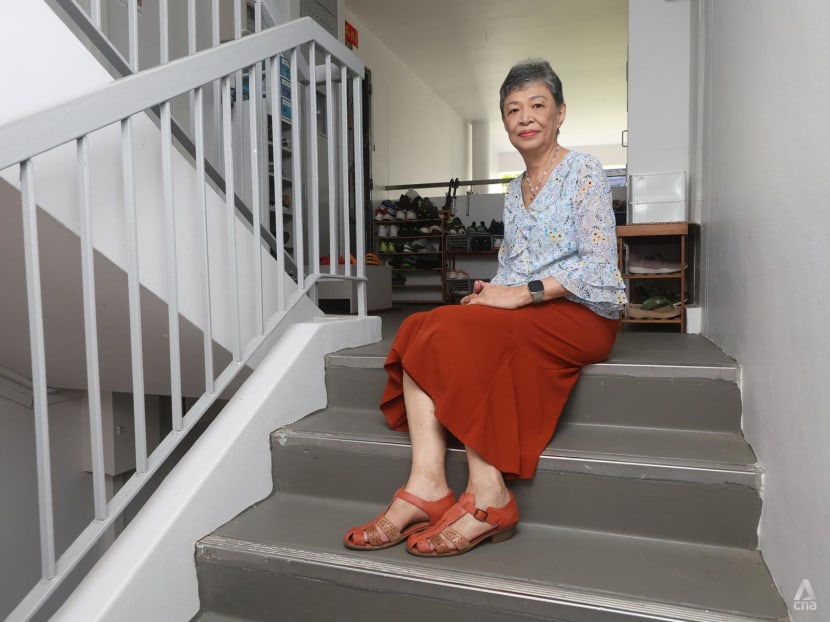
Retiree Kim Kay Eng, 68, at the staircase leading up to her flat at Block 531, Serangoon North Avenue 4, on Apr 10, 2025. (Photo: CNA/Ooi Boon Keong)

This audio is generated by an AI tool.
One night a few years ago, Madam Helen L had to call for an ambulance during a medical emergency and she needed to go to the hospital.
“It was about three or four years ago. In the middle of the night, I went to the toilet and suddenly felt very giddy. I felt like I was going to black out and I just kept vomiting,” the 77-year-old retiree said, declining to give her full name.
Then, paramedics had trouble locating her eighth-floor flat in the public housing block along Queen’s Road in Bukit Timah. They asked if she could meet them on the ground floor.
This is because the design of the housing block is rather unique. Built in the 1970s, the building’s two elevators stop only on the second, seventh and eleventh floors of the block. The lifts do not serve the eighth storey, where her unit is located.
To reach her flat from the ground floor, which is not served by a lift, one would have to climb a flight of stairs to the second floor, take the lift to the seventh floor, walk along a common corridor, then climb a flight of stairs to the eighth storey.
Because of her condition that night, she was unable to accede to the paramedics’ request. As a result, she had to wait several minutes for the responders to reach her home and carry her down.
Recalling this episode, Mdm L said that she is worried about ageing while living in her current flat.
“As we get older, our mobility is worse and physically we are weaker. Especially at our age, these are the most critical things we are scared of – getting a heart attack or a stroke. If someone is having an emergency or a heart attack, every second counts.”
There are 140 public housing blocks across Singapore that do not have direct lift access on every floor for various reasons, the Housing and Development Board (HDB) said.
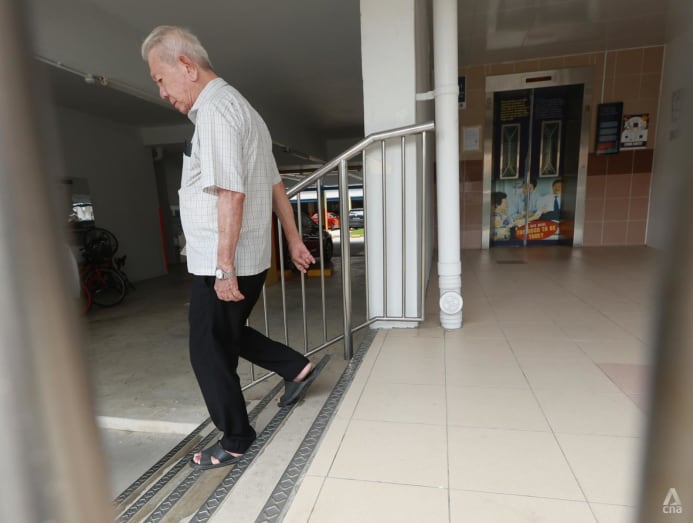
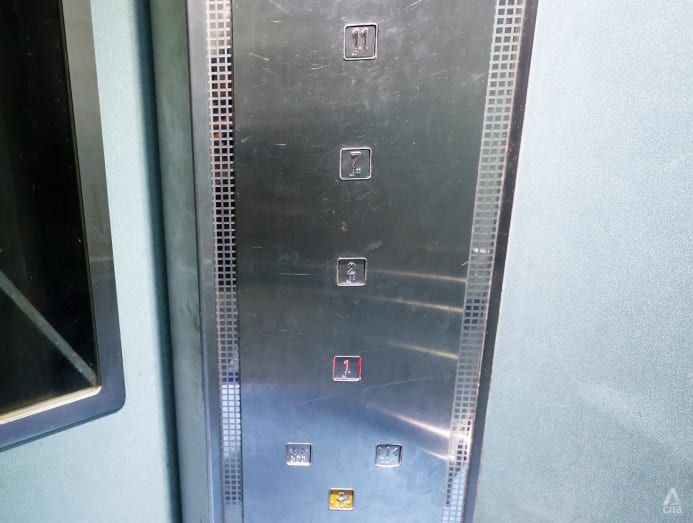
Besides the one on Queen’s Road, these blocks are also found in places such as Hougang, Serangoon North and the Nanyang division of the West Coast Group Representation Constituency (GRC), which covers parts of Jurong West.
The designs vary across the blocks in these estates. Some segmented HDB flats do not have direct access to lifts on the same level, even if the lifts in the block technically serve every floor.
Some HDB blocks are equipped with lifts that stop at alternate floors, while others such as the one where Mdm L is have lifts that serve only selected levels.
When asked why such blocks were built in the first place, HDB said that in the early years of Singapore’s development, there was an urgent need to build cost-efficient homes quickly to house the nation’s growing population.
HDB blocks were then designed with lifts that stopped only on certain floors in order to optimise land and accelerate construction.
Since the mid-1990s, though, all new HDB blocks have been built with lifts serving every floor, as residents’ lifestyle preferences and needs evolved.
Speaking to CNA TODAY, 10 residents living in older estates without full direct lift access said that they face a range of challenges daily that affect the lives of elders, the disabled and families with young children.
Some residents even said that they chose to stay home to avoid the hassle, raising wider concerns about social isolation.
Recognising these challenges, HDB launched the Lift Upgrading Programme in 2001 with the aim of upgrading lift services for affected blocks or retrofitting older blocks with new lifts, where feasible, to provide direct lift access to every floor.
To date, the programme has been implemented in more than 5,000 HDB blocks that were originally built without direct lift access to every floor.
However, the Ministry of National Development (MND) said in a written parliamentary response in September 2024 that there remains about 1 per cent of public housing blocks, comprising around 2,000 flats, that have not been offered the Lift Upgrading Programme due to high costs or technical constraints.
In some of these cases, the costs involved amounted to more than S$200,000 for each benefitting household, the ministry added.
For blocks that do not qualify for the programme, HDB offers residents a Lift Access Housing Grant to offset the purchase of a new or resale flat with direct lift access.
Last Sunday (Apr 6), the housing authority announced that the grant would be raised from a maximum of S$30,000 to S$80,000 for families, and from a maximum of S$15,000 to S$40,000 for singles.
Responding to queries from CNA TODAY, HDB said that as of Mar 31 this year, it has received 73 complete applications for the Lift Access Housing Grant.
Of these, 57 applications were approved, while nine are under evaluation.
Some residents have used the grant to help pay for units available within the same neighbourhood, so that they may continue to enjoy the familiarity of their neighbourhood and community, HDB added.


DREADING FALLS, PAYING DELIVERY SURCHARGES
To find out how residents are getting by, CNA TODAY visited three estates – the Queen’s Road area, Hougang and Serangoon North – that have HDB blocks without full direct lift access.
Ten residents aged between 25 and 77 living in these estates highlighted common challenges that they faced, including climbing the flights of stairs daily. This was especially the case for older residents and those with limited mobility.
Madam Kim Kay Eng, a resident of Serangoon North, said that it was highly inconvenient for her after she was discharged from the hospital last year and she felt “very weak” using the stairs. She was undergoing chemotherapy treatment for colon cancer at the time.
“I can walk down (the stairs), but it is very dangerous and I cannot use a wheelchair. If there (had been) a lift landing, I could have pushed (the wheelchair) in directly.”
The 68-year-old retiree also recounted an incident a few years back when her daughter fractured her leg and had to use crutches. As a result, she had to move out to stay with a friend elsewhere.
Several older residents said that when they bought their flats decades ago, they were young and fit. At the time, it did not matter to them that the lift did not serve their floors.
Then, as one 75-year-old resident Maggie Chan in Hougang said, growing older changed all of that.
Over the past 34 years of living there without direct lift access, her legs have developed worsening joint pain. These days, she has to think before a trip out if it were worth hobbling down the stairs.
Even though people like her can still move around without much assistance, they said they dread the day that their mobility worsens further, recalling encounters with other aged neighbours they have seen struggling at stairwells.
A 69-year-old resident living in Hougang who wanted to be known only as Mr Zhu said that he had seen elderly neighbours in wheelchairs having to be carried up and down the stairs by their domestic workers.
Mdm Kim the Serangoon North resident similarly expressed concern for her neighbour, who has had to help her husband up and down the stairs to their flat daily, ever since he suffered a stroke that impaired his mobility.
Because of these challenges, there is a sense among the neighbours that older residents in these flats are leaving their homes less frequently, thus suffering from the effects of social isolation.
Mr Alex Woh, 35, a grassroots volunteer, said that this is something he has observed among his older neighbours when he conducts house visits.
The Queen’s Road resident, who works in the aerospace industry, said that he has encountered elderly neighbours who avoid going out frequently due to the discomfort and inconvenience of having to navigate the stairs themselves.
Families with young children face difficulties as well, especially if they have a pram in tow or if they have to hold on to their child while carrying items such as groceries.
Mr Woh, a father of two children aged four and two, said that he and his wife rely on online deliveries for their groceries so that they do not have to manage too many items at a time when going out.
Some younger residents also said that they are always concerned about their older relatives who leave their flat to run errands.
On this point, Mr Tan Yi Hao, 25, said that whenever he helps his mother move groceries or heavy objects from the car to their flat, they have to take a longer path to return home. The housing block on Queen’s Road has lifts only serving the second, seventh and eleventh floor, while the car park is at street level.
That means that in order to get to their home on the sixth floor from the car park, Mr Tan has to go up a flight of stairs to get to the lift landing on the second floor, ride the elevator to the seventh floor and then go down a flight of stairs to reach their home.
The final-year university undergraduate also lives with his aunt, who runs a hair salon business. At times, she makes online purchases of bulky items such as steriliser machines to be delivered to their home.
The couriers would generally leave these deliveries at the lift landing on the seventh storey, and Mr Tan often has to help transport these items down the flight of stairs to their sixth-floor flat.

Several residents also said that deliveries often come with extra charges, as courier companies typically charge fees for transporting goods up and down stairs.
Ms Loo, a 48-year-old Serangoon North resident who works in the healthcare industry, said that just this week, she had to pay couriers a S$50 delivery surcharge to transport a new washing machine to her apartment and to dispose of her existing washing machine.
When asked if they would consider taking up the Lift Access Housing Grant and moving to a new flat with direct lift access, residents had mixed views. Some said that they may consider this down the road should they increasingly lose mobility or when their children move out.
Others showed a reluctance to move out of a neighbourhood they have grown up in, highlighting how their community and extended families are nearby.
A few of them added that the grant amount is insufficient to offset the high costs of buying a new home and lamented that they may not qualify for the full grant amount.
Speaking in parliament on Feb 18 this year, Minister for National Development Desmond Lee said that households facing “extenuating circumstances arising from medical or mobility challenges” may tap the grant to help them move to a new or resale flat with direct lift access.
However, Mdm L the Queen’s Road resident said that it may be tough to prove such extenuating circumstances, when older residents such as herself often face age-related mobility ailments that are not tied to specific medical conditions, potentially preventing them from receiving the full grant amount.
HDB’s website states that buyers would qualify for the full grant amount only if the replacement flat with direct lift access has enough lease remaining to cover the youngest buyer and their spouse or fiance until they are at least 95 years old. If not, the grant amount will be pro-rated.
RETROFITTING CHALLENGES
Responding to queries from CNA TODAY, HDB also said that it has piloted and adopted different technical solutions over the years to provide affected blocks with full lift access.
Some solutions that have been successfully implemented include installing lifts that do not require a machine room at the top of the shafts, which allowed lift upgrades to be offered to blocks with height constraints.
Machine rooms are typically needed because they house the motor, control systems and other essential equipment that power and safely operate the elevator.
In other cases, direct lift access was granted through the creation of new entry points to residents’ homes via existing balconies or living rooms.
The use of slightly smaller lift types known as home lifts was also introduced at some low-rise HDB blocks.
For the remaining 140 blocks without full direct lift access and that have not been offered the Lift Upgrading Programme, HDB said that this is mainly due to various “technical and site constraints”.
It has explored other lift systems such as the pneumatic vacuum elevator and the vertical platform lift for these blocks, but these were eventually assessed to be unfeasible for heavy residential use or unsafe to be independently operated by residents and were therefore not adopted, it added.
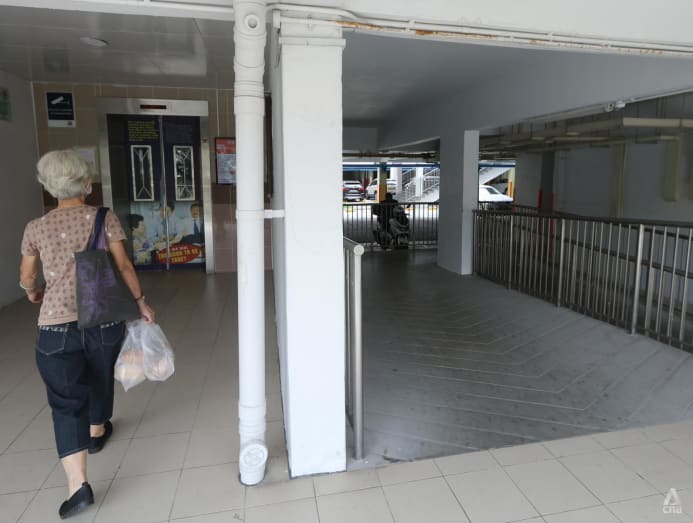
Engineering and lift experts told CNA TODAY that one main hurdle in retrofitting older HDB blocks with lifts that serve every floor is the lack of space to install new lift shafts.
Mr S Yogeesweran, co-chair of the Lift and Escalator Inspector Registry at the Institution of Engineers, Singapore, said that this could be worked around if the HDB block already has existing lift shafts that stop on alternate floors. Then, it may be easier to install lift entrances that can serve every floor.
On this point, Mr Foo Teik Yong, technical director at TUV SUD A-Reliance, a firm that provides testing, commissioning, inspections and safety audit services to the lift and escalator industry, said that such a solution would not work for several older HDB blocks that were previously built with lift entrances fitted at intermediate levels.
This refers to lifts that stop at a half-storey or a mid-level point between two storeys. Residents have to walk up or down a flight of stairs to access their respective floors.
In such cases, adding new lift entrances on every level would not solve the problem, because the entrances would still open at mid-landings between floors and residents would still have to use the stairs, Mr Foo added.
Mr Yogeeswaran said that this major limitation in older HDB blocks, where there is a misalignment between the lift landing and the housing unit's floor level, is rooted in the original building design.
It cannot be easily rectified because altering the lift landing to match each unit’s floor height may not be practical or structurally feasible.
“As of now, there is no practical solution to this problem. However, one potential workaround is for affected units to consider removing the front steps and installing a compact lifting platform at the entrance, though this may only be viable on a case-by-case basis,” he added.
To circumvent this, Mr Foo said that installing an external lift-well or external lift tower with entrances directly at each floor may be ideal, but this also depends on factors such as available space and finding a suitable placement for the lifts that ensures easy accessibility, even for residents with disabilities.
On the viability of alternatives such as installing stair lifts or gradual ramps, the experts said that these would require extra land space, which may not be available.
A stair lift is a motorised chair or platform that glides along a rail mounted to a staircase, offering those with mobility issues an option to move between floors without climbing the stairs.
To install stair lifts, Mr Yogeeswaran said that the existing stairway landing space must be widened to enable people to still smoothly travel up and down the stairs during an emergency.
Mr Foo said that a stair lift system may not be user-friendly to elderly users if no one is around to help them operate it.
As for ramps, Mr Yogeeswaran said that they might be unfeasible since such ramps would require a gentle slope in order for them to be useful in the first place.
This means that the ramps would typically need to take up considerable space – an option that may simply not be viable at some older HDB blocks or estates without significant redesign or land acquisition.
MAKING AN IMPERFECT SITUATION WORK
Members of Parliament (MPs) overseeing the affected blocks told CNA TODAY that alternative lift types or infrastructure such as ramps and chair lifts are suggestions that they have also sought to explore with residents and HDB.
Mr Christopher de Souza, for instance, said that options such as installing bubble lifts along the HDB block’s facade or having a separate lift shaft building connected to the HDB block by a concrete bridge were explored, but ultimately found to be unfeasible for various reasons.
He is the MP for Ulu Pandan under Holland-Bukit Timah GRC. Currently, about three blocks in his constituency – Blocks 2, 3 and 4 on Queen’s Road – still lack full direct lift access.
Having walked the estate grounds with engineers from MND and HDB, Mr de Souza said that in the estate, two blocks are located very close to or above the underground tunnel serving Farrer Road MRT Station.
To tile and construct new lift shafts could affect the tunnel’s structural integrity, which would compromise the safety of commuters and residents.
Mr de Souza said that this was also discussed: The possibility of building a separate lift shaft building connected to the HDB block by a concrete bridge, which would grant residents direct lift access via the backs of their homes such as through the kitchen instead.
However, this would mean erecting many concrete structures between the HDB blocks, which would compromise ventilation for the units and ultimately not be ideal for residents.
At the same time, residents in the estate were not overly keen on installing stair or chair lifts, because this reduces space in the stairwells for those who need to transport goods or bulky items up and down the stairs, Mr de Souza added.
Through his interactions with residents during house visits, he has tried to help match residents selling flats on lift-accessible floors with others who need direct lift access.
“It’s very much a local way of resolving community needs. It’s not perfect, but in this difficult situation, we will try to make it perfect,” he said.
“We are determined to make this imperfect solution as perfect as possible for residents.”
To combat the risk of social isolation, Ms Ng Ling Ling, MP for Jalan Kayu under Ang Mo Kio GRC, said that the town council is also exploring partnering with medical transport service providers to offer on-demand assistance to residents with mobility difficulties.
If this is successful, these providers may be called to help residents move safely between their flats and the ground floor or the nearest lift lobby.
Presently, six blocks in the estate under Ms Ng’s charge – Blocks 514, 522, 531, 532, 536 and 538 along Serangoon North Avenue 3 and 4 – still do not have full direct lift access.
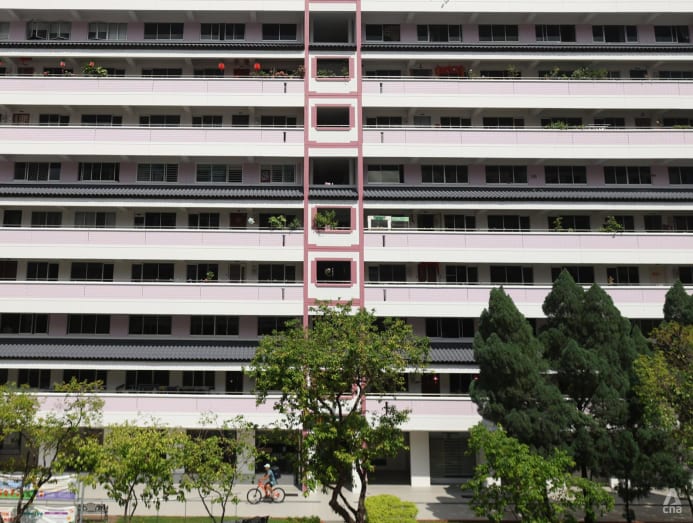
Apart from on-demand assistance services, Ms Ng said that grassroots volunteers, Ang Mo Kio Town Council staff members and the conservancy team continue to provide ad-hoc assistance to residents who need extra help due to mobility concerns.
The grassroots volunteers and community partners also conduct regular door-to-door visits to check on seniors and residents with mobility issues, to keep track of their well-being and to connect them with befriending services, social activities or medical support as required, she added.
Over in Hougang, MP Dennis Tan said that he has called on HDB to clarify if the constraints around retrofitting the older HDB blocks with full direct lift access are due to technical or cost reasons.
He noted that five blocks in his constituency – Block 363 Hougang Avenue 5 and Blocks 830, 831, 832 and 835 at Hougang Central – do not have direct lift access on every floor.
Speaking in parliament on Mar 4, Mr Tan had said: “I would like to call on the government to consider giving same floor lift access to all HDB flats where it is technically not impossible for access to be provided with the Lift Upgrading Programme, save for reasons of costs.
“A greater subsidy should be given. After all, the design oversight is no fault of the flat owners and it is a matter of equity for all HDB flat owners.”
Earlier this year, Block 833 in the same estate was approved to undergo lift upgrading under HDB’s programme.
Mr Tan said that he has not heard from HDB why the block has recently qualified for the programme when it was not approved for this previously.
Residents said that lift upgrading at their blocks of flats is still the ideal solution, because relocation to a different flat could come with another set of problems.
Mdm Kim the Serangoon North resident said that should she take up the Lift Access Housing Grant and move out, she foresees running into a different issue – that of selling her current flat.
“This 1 per cent (of flats without full direct lift access) is really unfortunate, due to our wrong choice (in the past). Who would want to buy this house with such a fault, unless I sell it very cheaply?”
Mdm L the Queen’s Road resident said: “My children are living quite near here. As I age, my desire is to live near my children, so that in the middle of the night if anything (happens) or I need help, I can call them.”
She added that she also enjoys the centralised location, peacefulness and security of her neighbourhood.
She acknowledged that it may be near impossible for the authorities to install a lift that serves her floor. Her children also know this and are urging her to live elsewhere.
“(As I age,) I want to go out, to be active, to enjoy myself, to mix with friends … and I need to leave the house," Mdm L said.
“If my leg cannot (make it) and I cannot go (downstairs), how? Then I would need to move out.”
















